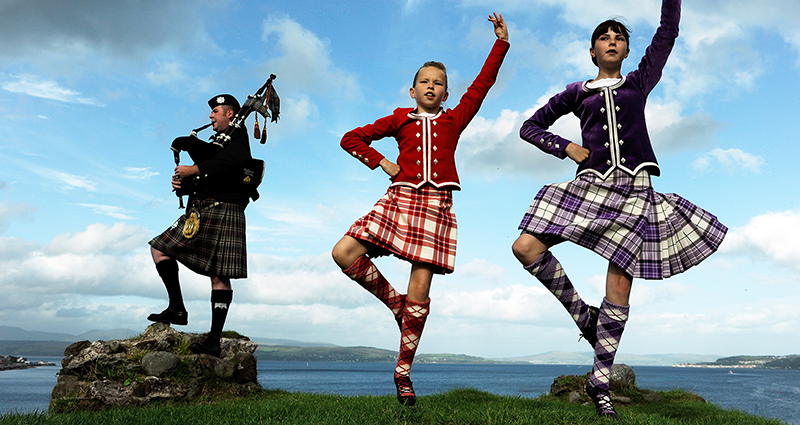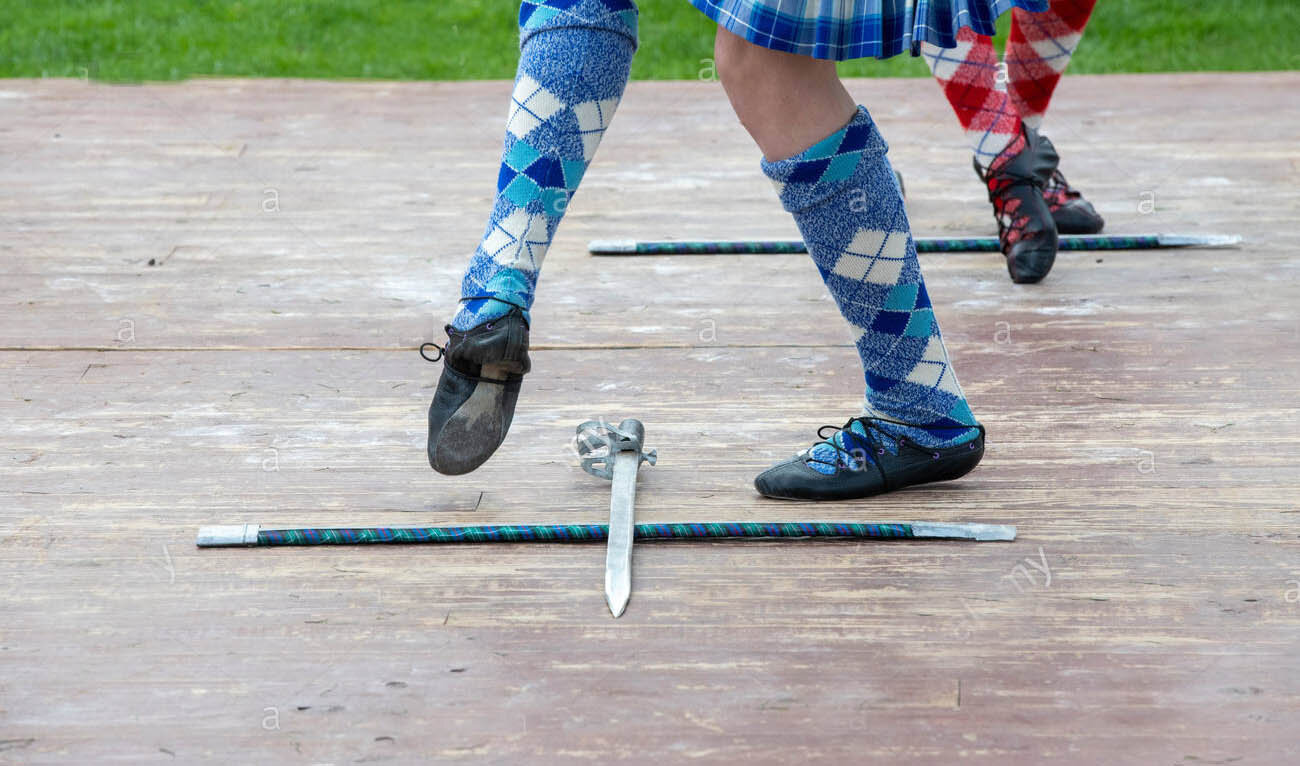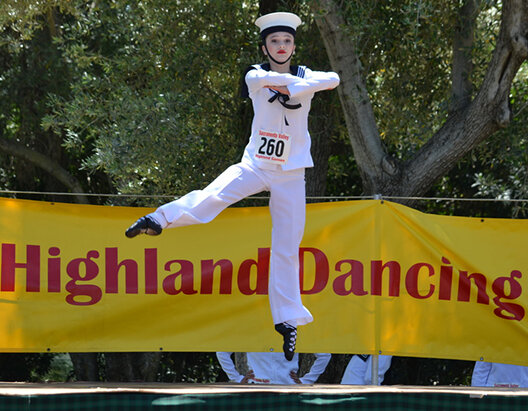Highland dancing
Highland dance or Highland dancing is a style of competitive dancing developed in the Scottish Highlands in the 19th and 20th centuries, in the context of competitions at public events such as the Highland games.
It was created from the Gaelic folk dance repertoire, but formalised with the conventions of ballet', and has been subject to influences from outside the Highlands. Highland dancing is often performed with the accompaniment of Highland bagpipe music and is seen at nearly every modern-day Highland games event.
The dances require technique, stamina and strength, and is recognised as a sport by the Sport Council of Scotland
| Highland dance should not be confused with Scottish country dance or cèilidh dancing, although they may be demonstrated at presentations and present at simular social events. |
|---|
| The difference to Irish dancing is (simplisticaly) Irish dancers rarely use their arms which are held beside their bodies (rather than raised above the shoulders), legs and feet are frequently crossed (not turned out at 45°), and frequent use of the hard-soled step shoes (compared to ghillies or 'pumps'). |
|---|
Types of dances
Scottish highland dances are generally divided into several types. Categories are more for convenience than strict style:
Highland dances
SWORD DANCE: it is suggested that the Sword Dance was developed 'as a necessary preparation for the management of the broad-sword... used in certain dances to exhibit their dexterity'; which includes dancing over two naked swords which are laid across each other on the floor.
In 1573 Scottish mercenaries are said to have performed a Scottish sword dance before the Swedish King, John III. The dance was used as part of a plot to assassinate the King, where the conspirators were able to bare their weapons without arising suspicion. Fortunately for the King, the act was not undertaken.
Many of the Highland dances now lost to us were once performed with traditional weapons that included the Targe shield, Lochaber axe, dirk and the flail.
HIGHLAND FLING: One theory about the Highland Fling is that it was a dance of triumph at the end of a battle. Another is that it was performed before battles on top of the dancer's shield. The shield would have a spike in the middle, around which the dancer would jump.
Another Fling story claims that it is meant to imitate a stag; the story goes that a boy who saw a stag was asked to describe it by his father – he lacked the words, so danced instead – the position of the hands resembles the head and antlers of a stag.
National dances
At Highland games, the National dances include
Scottish Lilt
the Earl of Erroll
Blue Bonnets
Hielan' Laddie
the Scotch Measure
Flora MacDonald's Fancy
Village Maid
Barracks Johnny, which illustrate the history of dancing and other aspects of Scottish culture and history.
Character dances
The sailor's hornpipe was adapted from an English dance, and is now performed more frequently in Scotland.
The Hornpipe mimics a sailor in her majesty's navy doing work aboard ship: hauling rope, sliding on the rollicking deck, and getting his paycheck. Performed in a British sailor's uniform, its name derives from the accompanying instrument, the hornpipe.
The Irish Jig is a humorous caricature and tribute to Irish step dancing (the dancer, in a red and green costume, is an interpretation of an Irish person, gesturing angrily and frowning).
The cakewalk is originally a dance performed by black slaves in the southern US imitating, in exaggerated style, the stately courtship ballroom dancing of slave owners.
It is unique in competitive Highland Dance as it is the only dance always performed as a duo and is the only dance that originated outside the British Isles.
Step dancing and clog dancing also used to regularly be part of some competitions.
Steps of each dance are now laid out in national and international syllabus such as the text books of the Royal Scottish Official Board of Highland Dancing (RSOBHD), United Kingdom Alliance Ltd (UKA), and British Association of Teachers of Dancing (BATD). Each dance comprises a number of steps, which may be numbered or worded. A RSOBHD four-step Highland fling may have the 1st step, 7th, 5th alternative, and finish with the 8th step; or, Shedding, Double shake and rock, Second back-stepping, and Last shedding.
Attire
Each dancing association (RSOBHD, SOHDA, VSU, etc.) sets the standard of dress. Items such as lipstick, earrings, face glitter, and the wearing of rings may be prohibited depending on the organisation.
Highland dance attire
Men wear traditional Scottish hat called a Balmoral and a doublet of coloured velvet or cloth. If the jacket is in the 'Prince Charlie' style then it is to be accompanied by a shirt and bow tie with a waistcoat, cummerbund or belt. Jackets in the 'Montrose' style are to be worn with a white lace jabot and, optionally, sleeve ruffles. A kilt and matching tartan hose are worn with a sporran, or tartan trews can be worn instead of a kilt for the Seann Truibhas.
Females wear a tartan kilt with a velvet jacket, worn with a lace insert, or a sleeveless velvet vest worn over a white blouse. The jacket or vest may be black or coloured with a gold or silver braid and buttons down the front. Matching tartan hose are also worn.
National dance attire
Males wear the same dress for National dances as Highland dances, however tartan trews may be worn instead of a kilt.
Females may wear a white dress with a tartan plaid over the right shoulder.
For National dances, female dancers may wear an 'aboyne' (after the Aboyne Highland Games, where women are not allowed to wear kilts for dancing to this day, and so an outfit was devised as an alternative). The aboyne dress consists of a velvet bodice over a white blouse with a tartan or tartan-like knee-length skirt and white underskirts. A tartan 'plaid' or 'plaidie' is worn with a Scottish-themed brooch pinned to the shoulder and waist.
They may also wear skin coloured tights or white socks.
Sailor's hornpipe attire
Both sexes wear the same outfit in either navy or white. A v-neck jumper is worn over a square-necked white vest with bell bottom trousers. A navy or light blue collar (with three stripes) and a sailor's regulation cap are also worn.
Irish jig attire
Irish jig shoes are black, green or red and, though they closely resemble ghillies, are hard-soled shoes with heels.
Males wear a Paddy hat, red or green muffler and tailcoat, brown or khaki breeches and a waistcoat in a contrasting colour to that of the tailcoat. A shillelagh, a kind of Irish cudgel, is carried for twirling.
Females may wear one of several combinations of red, green and white blouses, dresses, skirts and cummerbunds. Dancers also wear white underskirts and a white apron.
Cakewalk
While the cakewalk may be danced in traditional Scottish attire, dancers often attempt to come up with the most creative duo costume they can, such as Frankenstein and his bride, or Mickey and Minnie Mouse.
Highland games and competitions
Competitive highland dancers were initially only men. Women would take part in social dances, and girls did learn solo dances as part of their general dance classes.
In the late 19th century a young woman named Jenny Douglas (or possibly Lorna Mitchell) decided to enter a Highland dance competition – as this was not expressly forbidden, she was allowed to enter. Since then the number of females participating in the sport has increased to more than 95%.
Highland dancing competitions may be held solely or as part of larger events. As far as competitions were concerned, until the early 20th century the usual dances seen were the Sword Dance, the Seann Triubhas, the Strathspey and Highland Reel, the Reel of Tulloch, and the Highland Fling. Since then, various other (pre-existing) dances have been added to the competition repertoire.
Judging
Most judges today evaluate a dancer on three major criteria:
Timing concerns the ability of the dancer to follow the rhythm of the music.
Technique has to do with the correct execution of the steps in coordination with the movements of the rest of the body, including head, arm and hand movements. The ability of the dancer including the jumping height and the confidence.
Artistic interpretation and deportment covers that essential element of all dance and artistry in general which cannot be quantified or reduced to any set of rules or specific points, but which does concern the ability of the dancer or performer to convey a sense of feeling, understanding, and appreciation of the art form.
The various governing bodies of Highland dancing establish parameters for the dances themselves and scoring systems to grade the dancers and determine their class and progress from one class to another. The scoring system for these competitions begins with each dancer starting with 100 points. For any mistakes, poor execution, etc., results in subtraction of points at the judges discretion.
The notion of how dances were to be executed changed dramatically over the years. For instance, doing an early-20th-century-style sword dance in a competition today would get a dancer disqualified nearly immediately. There used to be terrible confusion as to what would be allowed (or prescribed) where, until the RSOBHD came up with a standard that has become acceptable to the majority of competitive dancers.
Source: Wikipedia














